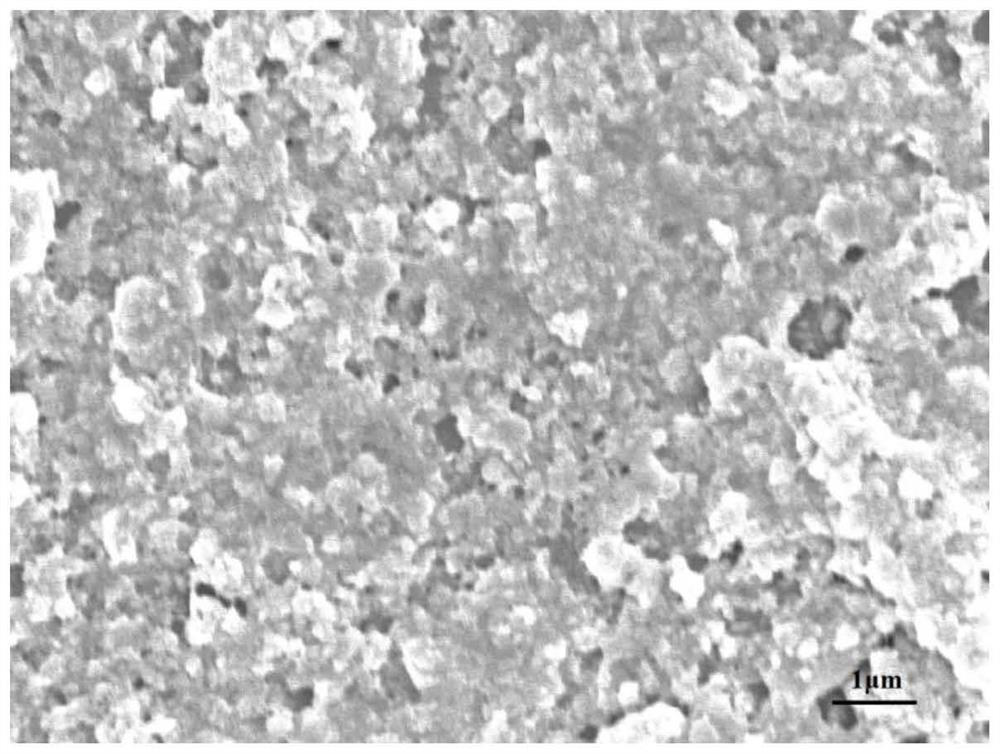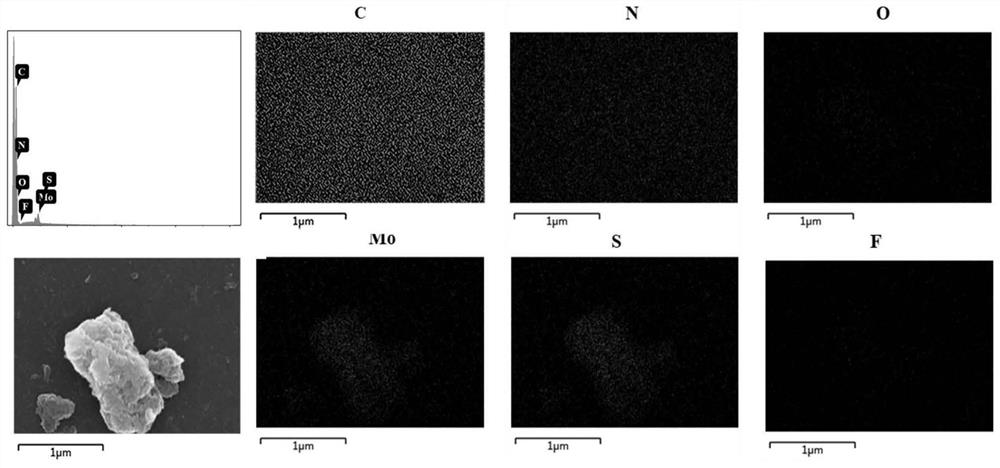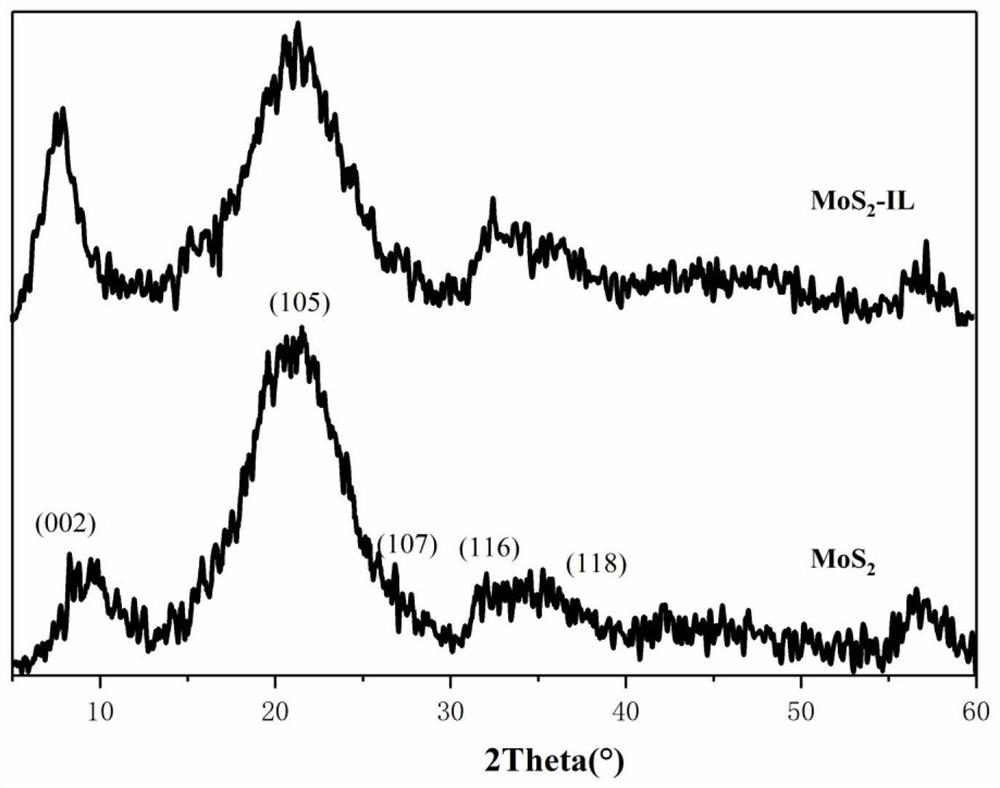MoS2-IL@CS electrochemical chiral sensor for recognizing tryptophan enantiomers and application thereof
An enantiomer, mos2-il technology, applied in the field of electrochemical chiral sensing, can solve the problem of limited conductivity of MoS2, and achieve the effects of wide practical application value, simple construction method, and single detection step.
- Summary
- Abstract
- Description
- Claims
- Application Information
AI Technical Summary
Problems solved by technology
Method used
Image
Examples
Embodiment 1
[0023] Example 1: MoS 2 -Synthesis and characterization of IL composites
[0024] 1. MoS 2 - Synthesis of IL composites
[0025] Dissolve 500 mg of sodium molybdate dihydrate in 50 mL of ultrapure water, then adjust the pH to 6.5 with hydrochloric acid. Subsequently, 1.00 g of L-cysteine and 100 mL of ultrapure water were added, and sonicated for 10 min. The mixed solution was then transferred to a Teflon-lined 80 mL autoclave and heated at 200 °C for 36 h. After cooling to room temperature, the solid product was collected by centrifugation, washed with ultrapure water and ethanol, and then dried in vacuum at 80 °C for 8 h to prepare MoS 2 .
[0026] 0.04g 1-benzyl-3-methylimidazolium tetrafluoroborate ([BZMLM]BF 4 ) joined MoS 2 The aqueous dispersion was continuously stirred at 60°C for 12h, then stirred at 90°C for 1h and filtered with a filter membrane with a diameter of 0.2μm. After washing with ultrapure water, the MoS 2 -IL composites were vacuum dried at 60 ...
Embodiment 2
[0039] Example 2: MoS 2 - Preparation of IL@CS Electrochemical Chiral Sensor
[0040] 1. MoS 2 -IL@CS Composite Membrane Modified Working Electrode
[0041] A three-electrode system was adopted, with a glassy carbon electrode (GCE) as the working electrode, a platinum wire (Pt) as the counter electrode, and a saturated calomel electrode (SCE) as the reference electrode. After thoroughly cleaning the electrode and testing its performance to be qualified, add 15 μL of 2 mg / mL MoS dropwise on its surface 2 -After the IL dispersion, it is placed in room temperature and dried naturally, and it is recorded as MoS 2 -IL / GCE. Subsequently, CS (2g / L, 0.1mol / L HAc) with a viscosity of 100-200mpa.s was deposited at a constant potential (-0.5V) at 20°C to 30°C, and the electrodeposition time was 200s. Wash the remaining CS solution on the surface with water and let it dry naturally at room temperature to prepare MoS 2 -IL@CS / GCE.
[0042] 2. Electrochemical chiral recognition of tr...
Embodiment 3
[0044] Example 3: Detection of a racemic mixture of tryptophan enantiomers
[0045] MoS 2 -IL@CS / GCE were respectively immersed in 500 μmol / L of PBS (0.1mol / L, pH = 6.0) After incubating in the solution for 1 min, use differential pulse voltammetry (DPV) detection, 0.4 to 1.0 V, with a potential increment of 4 mV, and record the DPV peak position. Such as Figure 7 As shown, with the increase of D-Trp%, the peak potential shifts positively, and D-Trp% has a linear relationship with the DPV peak potential: y=835.6880+51.3844x, R 2 is 0.9959.
PUM
| Property | Measurement | Unit |
|---|---|---|
| Viscosity | aaaaa | aaaaa |
Abstract
Description
Claims
Application Information
 Login to View More
Login to View More - R&D Engineer
- R&D Manager
- IP Professional
- Industry Leading Data Capabilities
- Powerful AI technology
- Patent DNA Extraction
Browse by: Latest US Patents, China's latest patents, Technical Efficacy Thesaurus, Application Domain, Technology Topic, Popular Technical Reports.
© 2024 PatSnap. All rights reserved.Legal|Privacy policy|Modern Slavery Act Transparency Statement|Sitemap|About US| Contact US: help@patsnap.com










